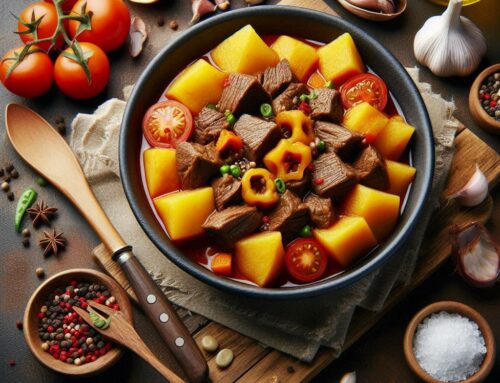
Introduction: Understanding Cassava and Its Culinary Potential
Cassava, also known as yuca or manioc, is a versatile root vegetable that plays a significant role in the culinary landscapes of many cultures around the world. Originating from South America, this starchy tuber has become a staple ingredient due to its adaptability and nutritional benefits.
One of the primary components derived from cassava is cassava starch, often referred to as tapioca. This gluten-free starch is prized for its thickening properties and is used extensively in both sweet and savory dishes. Its ability to create smooth textures makes it an ideal ingredient for puddings, soups, and sauces.
Beyond its textural benefits, cassava offers several nutritional advantages. It is rich in carbohydrates, providing a substantial energy source while being low in fat content. Additionally, cassava contains essential vitamins and minerals such as vitamin C and manganese.
When it comes to culinary uses of cassava, the possibilities are vast. The root can be boiled, baked, fried, or mashed much like potatoes. It serves as an excellent base for traditional dishes such as Brazilian pão de queijo (cheese bread) or West African fufu. Moreover, cooking with cassava can introduce unique flavors and textures into modern fusion recipes.
Understanding how to incorporate this adaptable root into your meals can expand your culinary repertoire while also tapping into the diverse benefits that cassava offers. Whether you’re looking to explore new tastes or seeking gluten-free alternatives in your cooking routine, cassava provides a promising avenue worth exploring.
The Nutritional Profile of Cassava and Its Health Benefits
Cassava, a starchy root vegetable widely consumed in many parts of the world, boasts a rich nutritional profile that makes it a valuable addition to various diets. One of the primary cassava nutrition facts is its status as an excellent source of gluten-free starch, making it an ideal option for those with celiac disease or gluten sensitivity. This tuber is not just about carbohydrates; it also contains significant amounts of dietary fiber, which aids in digestion and promotes a healthy gut.
The health benefits of cassava extend beyond its fiber content. It is also packed with essential vitamins and minerals. For instance, cassava provides vitamin C, which supports immune function and skin health. Additionally, it contains B vitamins such as folate and vitamin B6, crucial for energy metabolism and brain health.
Moreover, cassava is naturally low in fat and protein but can be combined with other nutrient-dense foods to create balanced meals that cater to diverse dietary needs. While incorporating cassava into your diet can offer numerous advantages, it’s essential to prepare it properly since raw cassava contains cyanogenic glycosides that can be harmful if not adequately cooked.
In summary, the nutritional profile of cassava highlights its role as a versatile food source that offers various health benefits when prepared correctly. Whether you’re seeking gluten-free alternatives or looking to enhance your intake of dietary fiber and vitamins, cassava presents itself as a nutritious option worth considering.
Cassava vs. Other Common Starches: What Makes It Unique?
Cassava stands out among common starches due to its unique properties and versatility in cooking. When comparing cassava vs. potato starch, one of the most notable differences is their texture and binding capabilities. Cassava starch, derived from the root of the cassava plant, offers a smooth and elastic texture that makes it ideal for creating glossy sauces and soups. In contrast, potato starch tends to produce a thicker consistency, which can be beneficial for heartier dishes.
Exploring tapioca vs. cassava flour reveals another layer of complexity in understanding this versatile ingredient. Both are derived from the same plant; however, they serve different purposes in culinary applications. Tapioca flour is processed to create small pearls or a fine powder used for thickening puddings and pie fillings, while cassava flour retains more of the whole root’s fiber content, making it suitable for gluten-free baking as a wheat flour substitute.
When comparing starches for cooking, cassava’s unique properties become apparent through its neutral flavor profile and ability to perform well under various cooking conditions without altering taste or color significantly. This makes it an excellent choice for those seeking allergen-friendly options or experimenting with new recipes that require reliable thickening agents without compromising on quality or flavor.
Culinary Uses: How to Incorporate Cassava into Your Nighttime Meals
Cassava, a versatile and gluten-free root vegetable, opens up a world of culinary possibilities, especially when it comes to crafting delicious nighttime meals. Cooking with cassava flour is an excellent way to add variety and nutritional value to your dinner recipes. Here are some easy and innovative ways to incorporate cassava into your evening dishes.
One popular option is using cassava flour as a substitute for traditional wheat flour in gluten-free nighttime dishes. Its naturally smooth texture makes it perfect for creating light and fluffy pancakes or savory crepes that can be filled with your favorite ingredients like spinach, cheese, or mushrooms.
For those looking for hearty dinner recipes with cassava, consider making a classic shepherd’s pie. Replace the potato topping with mashed cassava for a unique twist on this comforting dish. The subtle flavor of cassava pairs wonderfully with the rich filling of ground meat and vegetables.
If you’re in search of easy dinner ideas with cassiva, try making crispy cassava fritters. Simply grate the cassava root, mix it with herbs and spices, form small patties, and fry them until golden brown. These make for an excellent side dish or appetizer that everyone will enjoy.
By exploring these cooking techniques and recipes, you can effortlessly incorporate this nutritious ingredient into your nightly meals while enjoying the benefits of gluten-free dining.
The Versatility of Cassia in Various Cuisines Around the World
Cassava, often hailed as a staple ingredient across various continents, showcases its versatility in numerous global cuisines. From Africa to Asia and Latin America, cassava dishes from different cultures highlight the adaptability and appeal of this root vegetable.
In African cuisine, cassava is a fundamental component of traditional recipes. For instance, in West Africa, it is commonly transformed into fufu—a dough-like dish served alongside rich stews and soups. Similarly, in East Africa, cassava flour is used to make ugali or posho, which are essential parts of daily meals.
Moving to South America, cassava plays a significant role in Brazilian culinary traditions. One popular dish is pão de queijo—cheese bread made with cassava flour—that offers a delightful combination of crispiness on the outside and chewiness on the inside. In Peru and other Andean countries, yuca frita (fried cassava) serves as a beloved street food snack or side dish.
Asian cuisines also feature unique uses of cassiva. In Indonesia and Malaysia, traditional desserts like kelepon—a sweet rice cake filled with palm sugar—often incorporate grated cassiva for added texture. Meanwhile, in India’s southern states such as Kerala and Tamil Nadu, kappa (boiled tapioca) accompanies spicy fish curries for an authentic taste experience.
These international casivva dishes not only demonstrate its culinary flexibility but also underscore its importance as a dietary staple worldwide. Whether boiled or fried; sweet or savory; served solo or paired with other ingredients—the global appreciation for this humble root continues to grow through innovative adaptations across diverse gastronomic landscapes.
Sustainable and Economic Benefits of Using Casivva as a Staple Ingredient
As the world increasingly turns its attention to sustainable living, the search for eco-friendly and cost-effective staple ingredients has intensified. Casivva, an emerging player in this arena, presents a promising alternative to traditional staples like wheat, rice, and potatoes. The sustainability of growing casivva lies in its resilience and adaptability. Unlike many conventional crops that require extensive water resources and are vulnerable to climate change impacts, casivva thrives in diverse environmental conditions with minimal water usage.
The cost-effectiveness of using casivva as a staple ingredient cannot be overstated. Its cultivation demands fewer inputs such as fertilizers and pesticides, which translates into lower production costs for farmers. This affordability extends to consumers who benefit from a nutritious staple that doesn’t break the bank.
Environmentally friendly crop alternatives are crucial for reducing agriculture’s carbon footprint. Casivva contributes to this goal by promoting soil health through its natural resistance to pests and diseases, thus minimizing chemical interventions. As we seek viable alternatives to wheat, rice, and potatoes, incorporating casivva into our diets not only supports sustainable agriculture but also paves the way for more resilient food systems worldwide.






